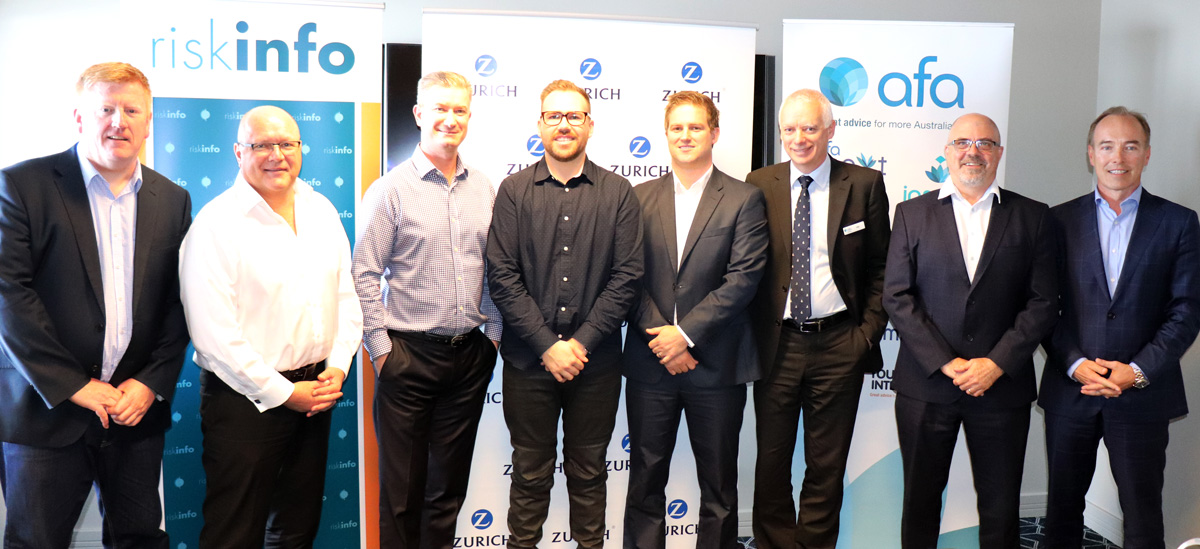Riskinfo joined with the AFA and Zurich Financial Services Australia at this year’s AFA National Adviser Conference to conduct an industry Round Table discussion looking at how advisers, associations, insurers and other stakeholders can innovate across insurance products and services, while also making the provision of advice more efficient.
Table of contents (Click these links to move directly to those topics)
Part 1

Panelists (L – R)
- Jason Spits: Senior Journalist, Riskinfo, Editor, Riskinfo Magazine
- Peter Sobels: Publisher, Riskinfo
- Phil Kewin: CEO, Association of Financial Advisers, Co-host
- Glen James: Managing Director, Fortify Financial
- Andrew Rataj: Senior Financial Planner, PFG Financial Services
- Phil Anderson: GM Policy & Professionalism, Association of Financial Advisers
- Rod Severn: CEO, Professional Advisers Association, NZ
- Peter Mitchell: National Sales Manager, Life Risk, Zurich Financial Services Australia, Co-host
The panel agreed innovation was not limited to life insurers and that advisers had a role to play in delivering the feedback required to improve products. At the same time, the panel found that the greatest impediment to business efficiency was not being required to comply with new regulations but rather how advisers and licensees chose to use technology to build their own in-house systems and processes.
Read on to find out what your fellow advisers and other industry stakeholders had to say about these issues.
Innovation: Products – Back to top
Financial advice has always been about knowledge applied to a client’s situation that most often includes a product as part of the solution, and having access to good products is therefore important for advisers and their clients. At present, the life insurance sector has plenty of products on offer, but what innovations would advance their delivery and enhance the quality of advice solutions, to consumers?
Simplicity has to be first and foremost on our agenda
For PFG Financial Services, Senior Financial Planner, Andrew Rataj, a return to simpler products would be useful for clients who are seeking less sophisticated solutions, but he recognises these products may not be sustainable for life insurers.
“Simplicity has to be first and foremost on our agenda as it sometimes appears there’s an arms race on to enhance products and make them more complicated with greater features, where advisers think it should go the other way,” Rataj said.
“We feel that a basic model where you can add on the features that match client needs, particularly within a best interests duty world, would be beneficial – but that is very difficult with the more complicated products currently available,” he said.
Rataj sees a joint responsibility for the sector in bridging the gap between consumers who have little knowledge and advisers and insurers who have the products and the understanding on how to use those products.
“It’s everyone’s responsibility to simplify the products that reach consumers. It starts with product manufacturers, and I understand they are in business as well, and the ‘stripped-out’ products are probably not where the margins are made. So, then, it comes down the line to advisers who try to explain these features to clients, and ascertain what’s important and what is the best option for them,” Rataj said.
For fellow adviser, Glen James, Managing Director at Fortify Financial, product innovation needs to encompass sustainability to ensure advisers are confident they can recommend a product for the long term.
the biggest risk is level premiums increasing over time and turning out to be unsustainable for clients
“I write a lot of level premium because I know as medical advances take place that it will be harder to get cover for some people. But the biggest risk is level premiums increasing over time and turning out to be unsustainable for clients,” James said.
“For me, simplicity and sustainability comes back to the product providers which have thousands of products on legacy systems and old technology, and I’m unsure if that situation will improve,” he added.
Addressing the issue of product innovation and simplicity from a manufacturer’s perspective, Peter Mitchell, National Sales Manager for Life Risk at Zurich Financial Services Australia, said creating greater financial literacy around life insurance can help make the products and concepts more accessible.
“To do this we have to understand the customer journey and remove the pain points and provide access to good quality advice. Financially, insurance can be considered as a burden as well as being complex, so before people even consider insurance it’s already quite easy for them to say ‘no’ to it. I see a large part of our role as removing pain points so that a client is more likely to remain engaged throughout the entire process,” Mitchell said.
He added that a move towards genuine simplification needs stakeholders from across the value chain to come together and get on the same page, “…and that means advisers, licensees, compliance teams and researchers,” he said.
More does not necessarily equal better
Mitchell continued, “There are opportunities across the board to really simplify language, documentation, process and product design, but it will require many people in many different roles to rethink their perspectives on the relationship between complexity and protecting the customer.
“More does not necessarily equal better,” he told the panel, “…and yet there are some structural factors which seem to result in advisers being left with little choice but to recommend fully featured products.
“The modularised approach certainly has a role to play, and we would expect that the increasing digitalisation of policy platforms and purchasing channels will ultimately drive more flexibility in a way that doesn’t make the purchasing process even more complicated, said Mitchell.”
James agrees that this type of client education about the merits of simplicity and complexity should be taking place through advisers because they are the only people talking with risk clients on a regular basis and are ‘re-selling’ and ‘re-educating’ them about the purpose and value of life insurance.
“We are specialists in what we do, and the clients are good at what they do. They just need to know what they’re covered for and what they’re paying for. I position this with my clients in ongoing education, so in three years’ time I don’t get a call where a client says they’re fed up with paying $200 a month,” James said.
This issue of affordability sits alongside questions of simplicity and sustainability, with both Rataj and James claiming increases in premiums plays a key role in whether a client retains a policy with any life insurer.
“Any time we see policies cancelled, affordability is usually the main concern. Clients receive their renewal notice with an increase premium and they can’t stomach that. They’re used to seeing a lower figure year on year and then to get a jump rings alarm bells,” Rataj said, adding that his business uses an even mix of level and stepped premiums products, but where concerns remain about premium increases for the latter.
Rataj said this creates uncertainty because the advice has been sold and the product placed on a sustainable and affordable basis for the client, while James believes this uncertainty rests with how insurers price and reprice the risk on their books.
For AFA Chief Executive, Phil Kewin, this is an issue of security for advisers and their clients that will become even more important in the near future and he asked, “How can an adviser know when recommending a product that it is not at a different stage in the price cycle than the adviser believes?
“The reason I ask that is because it’s a real concern for advisers who are making recommendations with good intent and expecting those products to be part of the ongoing advice solution, only to see a sudden increase in premiums. This then puts pressure on the adviser to ensure they act in the clients best interest with the added pressure of lapse reporting hanging over their heads,” Kewin said.
Innovation: Services – Back to top
One way of easing pressure on advisers is making improvements to the services that are available to them, which most commonly takes place through the technology deployed by life insurers for use by financial advisers.
Great improvements have been made in this area by insurers but, according to Rataj, not all service providers have been able to keep pace with the evolving needs of advisers, and some advisers have not kept up with the changes going on around them.
“The insurers are making great progress on the technology side, particularly in some of the portals that we now have access to that have innovative ways to underwrite, to quote and to lodge applications. As advisers, we have got to get better using technology to deliver advice particularly in the face of a reduction in remuneration, increased best interests duties and ongoing review of policies,” Rataj said.
“We need more tools on the research side so advisers can effectively and efficiently do the front end for the lodgement, and once you’ve past the lodgement and the quoting side, the technology and systems are pretty good,” he said.
life insurance is a long way behind when trying to tailor products and add features
Kewin also questions the validity of life insurance product research, commenting that his experience has been that advisers find it difficult to recommend a product that is not well rated, even though it possibly offers better value for money. “When compared to the managed funds sector, which has a wealth of research available on products, in the life space it’s more difficult to justify a product recommendation without supporting research,” he said.
Comparing risk product and investment product research, Rataj said life insurance is a long way behind when trying to tailor products and add features.
“The services that are out there – the technology is pretty vanilla in terms of what it provides, but you have still got to go away and input quotes and the client name three times into three different pieces of software, and hope you’ve matched up the features of each one, and see what it generates,” Rataj said.
Adding to this James said it was important for product and service providers to remember that advisers are their clients and, in the same way that he removes pain points for clients, he would like to see providers doing the same for advisers, particularly around retaining clients.
According to James, advisers are well assisted in an easy and seamless process of getting clients on board but making a change to a policy required reams of paper and printed applications that have to be filled out by hand.
Rod Severn, Chief Executive of the Professional Advisers Association in New Zealand, said “…it’s not as though this isn’t something that hasn’t been asked for, because it’s been high on the list, particularly in the context of all the discussion around product replacement. Why wait for [new] product if you can quickly and easily upgrade the existing?”
“Advisers have to be out there with their products. So, what’s going to make it easy for them to go and represent that to the consumer?” Severn said.
The review of existing clients comes up all the time. That is one of the biggest pain points
While the life insurance advice industry has seen a maturing of the relationship between adviser, insurer and client over the past few years, more work still remains around improving client retention, according to Kewin.
“The review of existing clients comes up all the time. That is one of the biggest pain points, and the fact that it’s far easier at times to write a new product than it is to modify an existing product,” Kewin said.
“It’s just got a sharper edge to it now, given the environment of lapse reporting and the Life Insurance Framework. You may be doing the right thing by your clients [in changing products] because it’s more affordable for them, but that means you might go on a register because you replace more products than you should have,” he added.
The conditions described by Kewin, introduced by Government through legislation, will drive change in the life insurance and advice sectors but Mitchell sees making change as something that has to be properly planned and executed to avoid creating more problems.
“We have a huge focus on how we can deliver our strategies and become more efficient from an underwriting perspective. We’re dealing with a huge amount of data. How can we streamline our processes to get through that data so that we don’t make errors? How can we deliver that information to our clients and advisers so they can spend time with their client to remove a lot of those financial literacy issues?” Mitchell said.
For the advisers, breakthrough service innovations differ, with Rataj opting for more tools and James opting for more logic in meeting client needs.
Asked what would be a game-changer for him, Rataj pointed back to the problems he sees with research and called for a solution that would provide live information about what a policy would cost a client as they worked through their current needs and situation.
“At the moment the process is to gather information, go away and do what you need to do, and then go back to the client. We need to be able to sit with clients, tailor it as we go, and bring the issue of affordability right into the initial discussion. The problem is that clients don’t understand what the risk is likely to cost and the place to get on top of those discussions is earlier in the process,” Rataj said.
Responding to the same question, James encouraged fellow advisers to not over-complicate what they do and use their skills and experience to guide their actions.
“When I recommend a quality product to a client, am I going to move them if a different product is released and is rated higher than the one I’ve recommended? That kind of logic is flawed, because it ignores the fact I’ve set this advice for the long term,” James said.
“In terms of efficiency it’s like having an air-conditioner installed and I get the best one for my needs because the installer has that kind of relationship and gets that sorted for me. As a client, I just need confidence that the installer can sort things out for me and I don’t really care what label is on it,” James added.
“Taking that back to the advice model where I have two or three insurers with whom I have good relationships and that makes my life easier. This makes my clients’ lives easier and cheaper, because I’m more efficient and I can charge less, and charging less doesn’t mean being less profitable if you’ve got the right efficiencies in place.”













